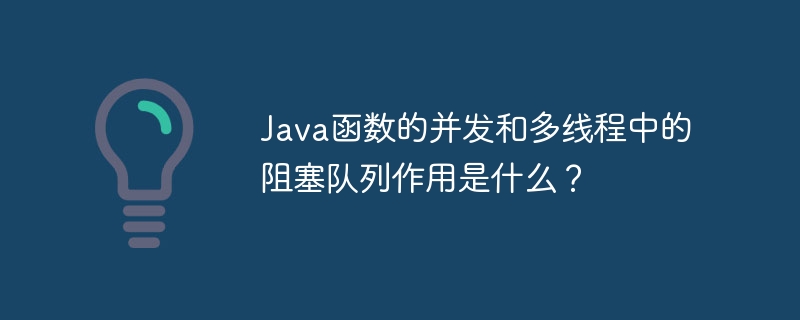Home >Java >javaTutorial >What is the role of blocking queue in Java function concurrency and multi-threading?
What is the role of blocking queue in Java function concurrency and multi-threading?
- 王林Original
- 2024-04-27 09:30:011262browse
Blocking queue: a powerful tool for concurrency and multi-threading Blocking queue is a thread-safe queue that plays the following key roles in concurrent and multi-thread programming: Thread synchronization: Prevent race conditions and data inconsistencies by blocking operations . Data buffer: As a data buffer, it alleviates the problem of mismatch in producer and consumer thread speeds. Load balancing: Control the number of elements in the queue and balance the load of producers and consumers.

Blocking Queues in Java Functions: A Powerful Tool for Concurrency and Multithreading
Introduction
Blocking queue plays a vital role in Java, which provides an efficient and coordinated way for concurrent and multi-threaded programming. It acts as a buffer between producer and consumer threads, ensuring safe and reliable delivery of data.
What is a blocking queue?
The blocking queue is a queue data structure that supports thread-safe operations. It provides two main operations:
-
put(element): Adds an element to the end of the queue. If the queue is full, the producer thread will be blocked. -
take(): Remove elements from the head of the queue. If the queue is empty, the consumer thread will be blocked.
The role of blocking queue in concurrency and multi-threading
In concurrency and multi-threading scenarios, blocking queue manages the relationship between producer and consumer threads The communication plays multiple roles:
- Thread synchronization: Blocking operations ensure that threads only execute when specific conditions are met, thus preventing race conditions and data inconsistencies.
- Data buffering: The queue acts as a data buffer to prevent the speed mismatch of the producer and consumer threads.
- Load balancing: Blocking queues can balance the load of producers and consumers by controlling the number of elements in the queue.
Practical Case: Concurrent File Processing
Consider an example where multiple files need to be processed in parallel. We can use a blocking queue to achieve this task:
import java.util.concurrent.ArrayBlockingQueue;
public class ConcurrentFileProcessor {
private final BlockingQueue<File> queue;
private final int numWorkers;
public ConcurrentFileProcessor(int capacity, int numWorkers) {
this.queue = new ArrayBlockingQueue<>(capacity);
this.numWorkers = numWorkers;
}
public void processFiles(List<File> files) {
// 生产者线程
Thread producer = new Thread(() -> {
for (File file : files) {
try {
queue.put(file);
} catch (InterruptedException e) {
e.printStackTrace();
}
}
});
// 消费者线程
for (int i = 0; i < numWorkers; i++) {
Thread consumer = new Thread(() -> {
while (true) {
try {
File file = queue.take();
// 处理文件
} catch (InterruptedException e) {
e.printStackTrace();
}
}
});
consumer.start();
}
producer.start();
producer.join(); // 等待生产者完成
}
}In this example, the blocking queue is used to manage the file flow between the producer thread and the consumer thread. Producers put files into a queue, and consumers read and process files from the queue. Blocking operations ensure that consumers are blocked when the queue is empty and producers are blocked when the queue is full, resulting in smooth and efficient parallel file processing.
The above is the detailed content of What is the role of blocking queue in Java function concurrency and multi-threading?. For more information, please follow other related articles on the PHP Chinese website!

